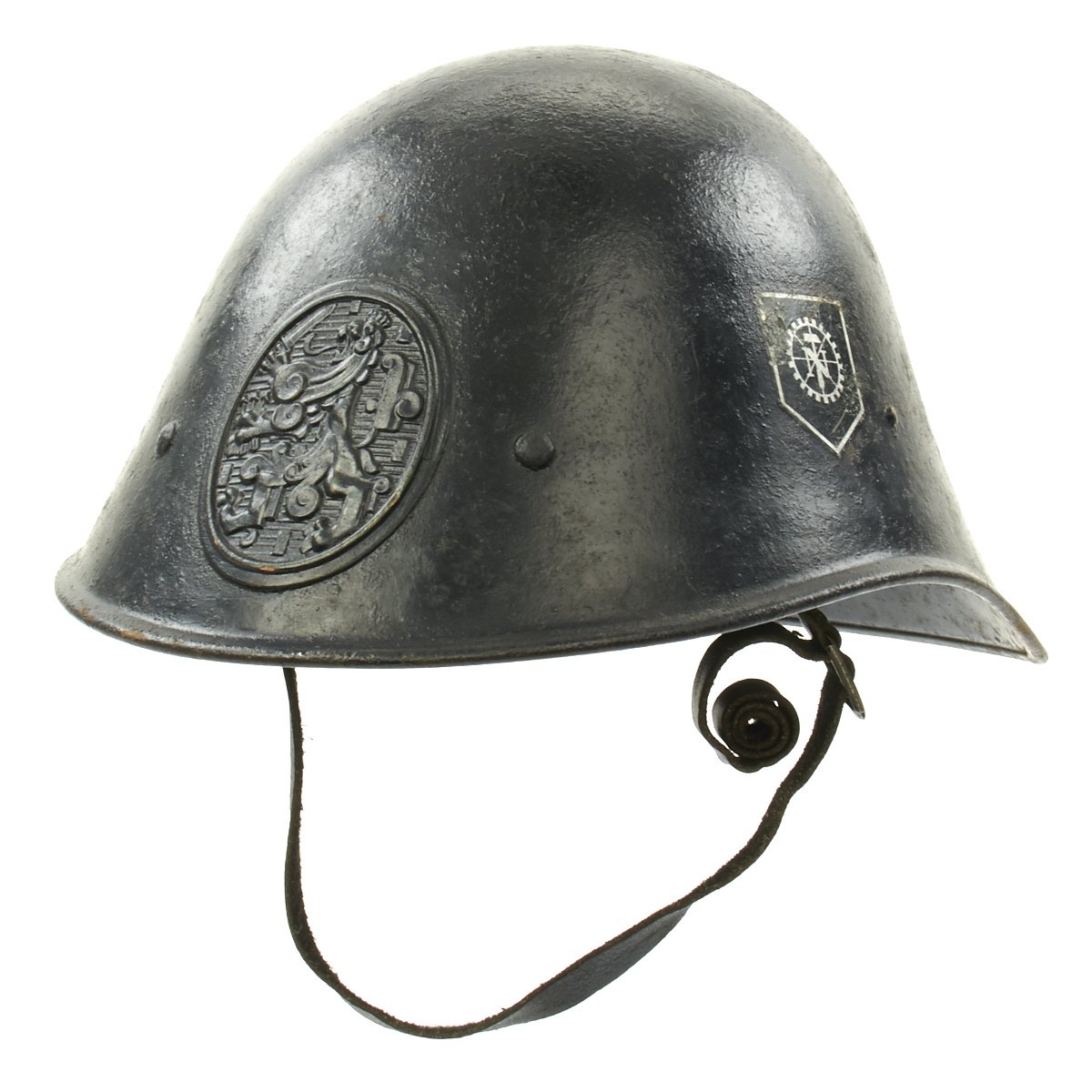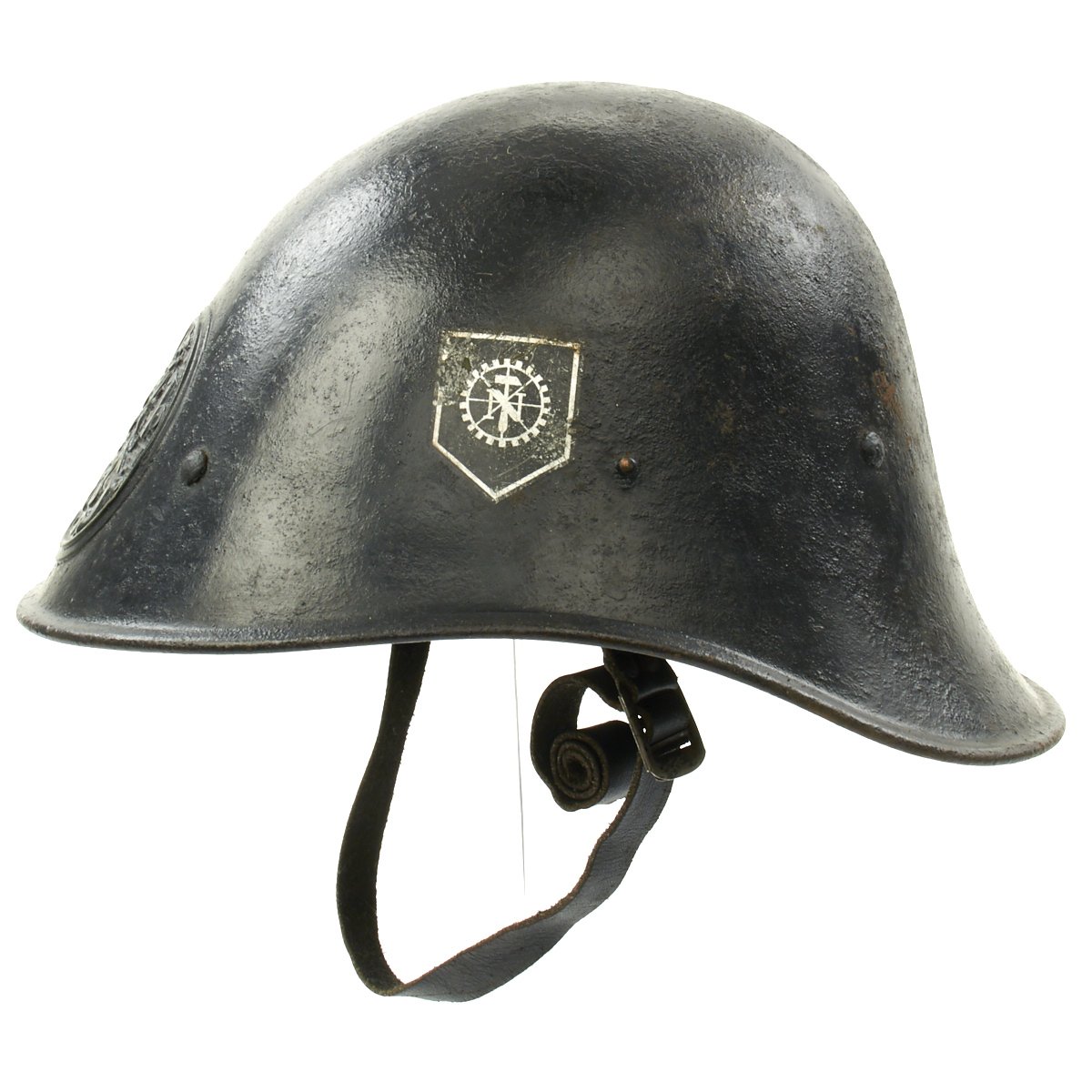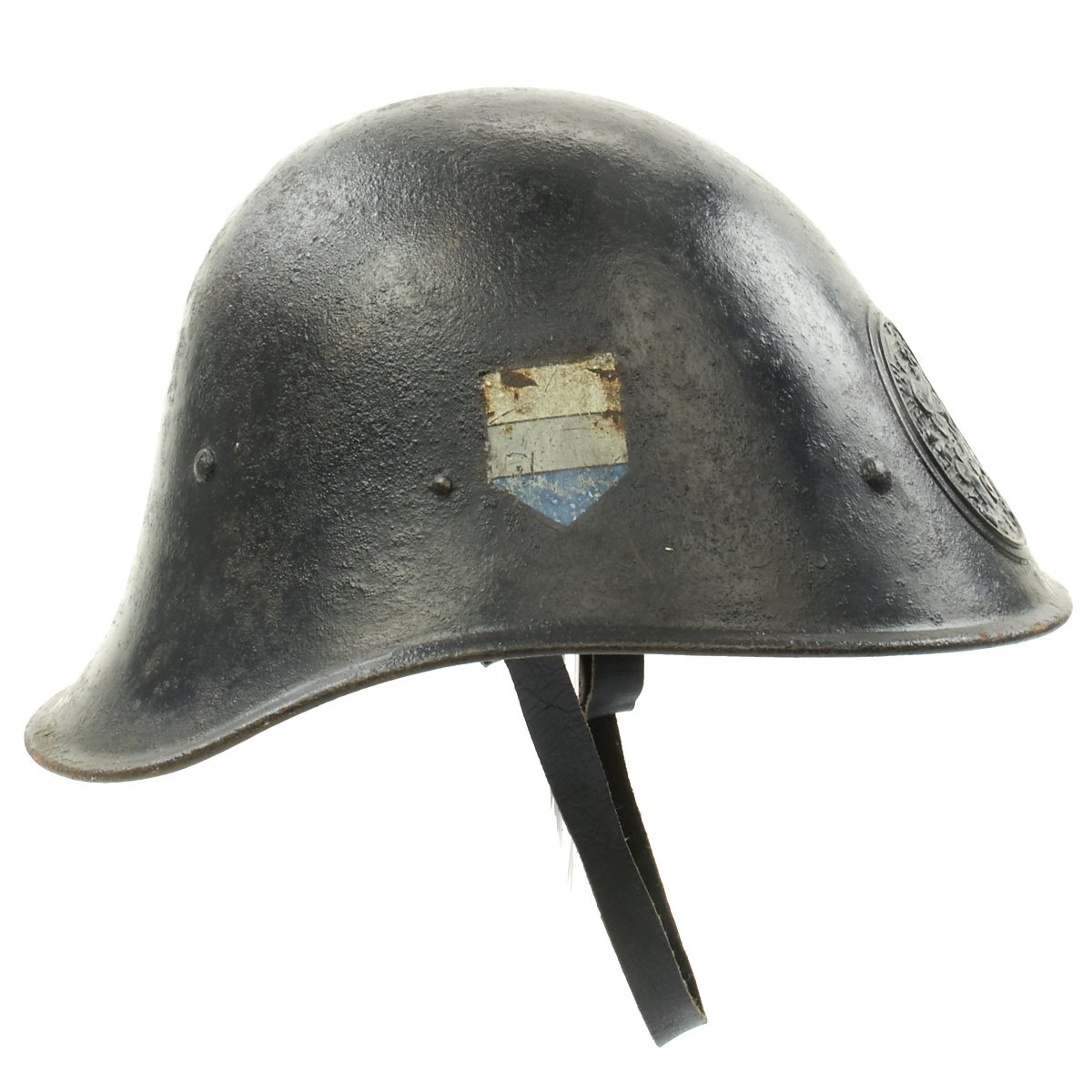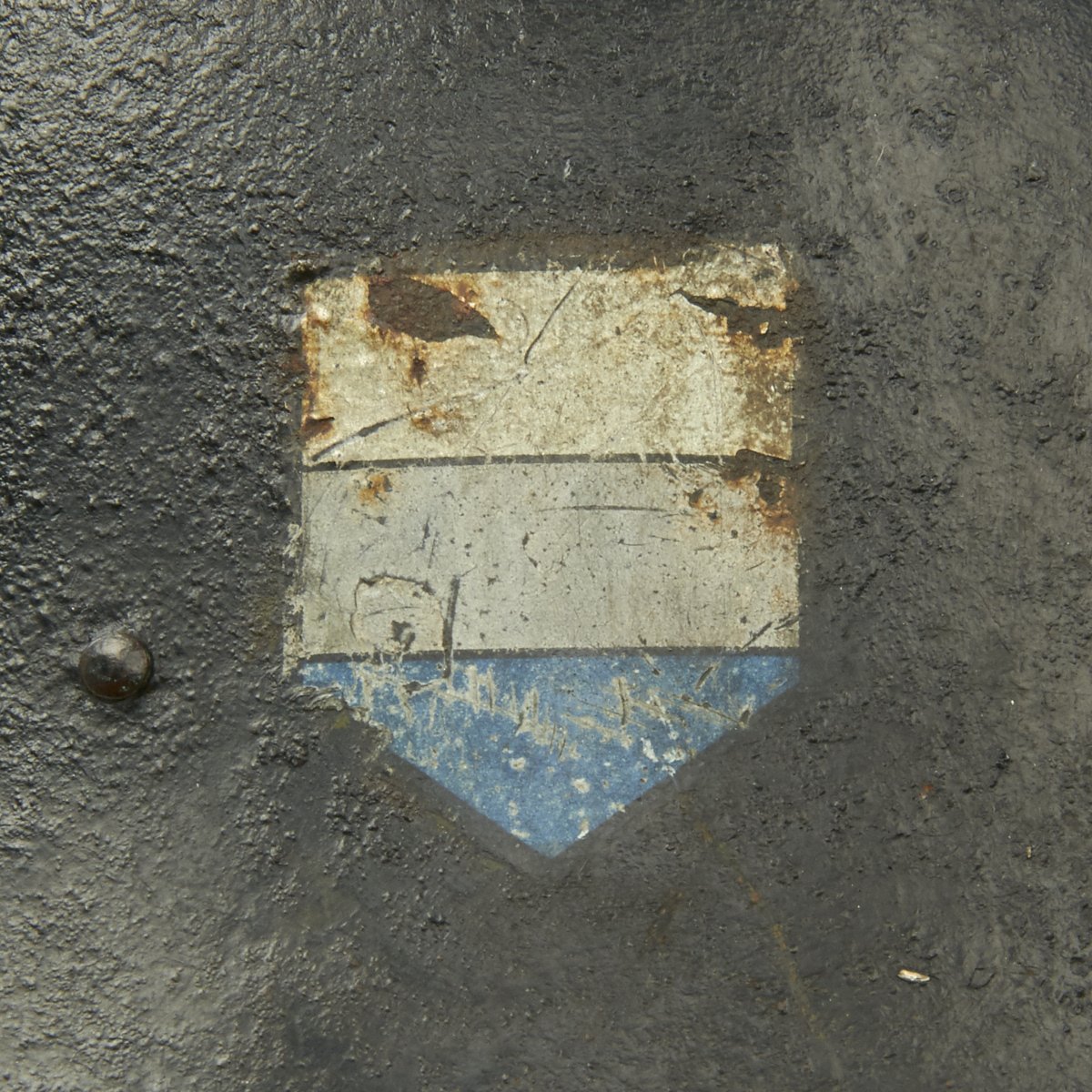Original Dutch WWII Model 1934 German TENO Helmet Original Items
$ 750,00 $ 225,00
Original Item: Only One Available. Technische Nothilfe (abbreviated as TN, TeNo, TENO; literally: ‘Technical Emergency Help’) was a German organization. It began as a strikebreaker organization after the first world war, but developed into a volunteer emergency response unit. During the NSDAP period TN became in charge of technical civil defense.
This is a very nice condition original M34 Dutch WW2 helmet which was converted to a TENO service helmet by German occupation forces. Features correct genuine period decals and black paint. The decals are not the commonly seen round bottom fakes that can be found on the market occasionally. Helmet is steel construction with original inlaid copper shield depicting the Dutch Republic Lion or the Coat of Arms of Netherlands. Complete with liner and chinstrap. Overall condition is very good, size is approximately 7 1/4 (58cm).
The history of the Netherlands from 1939 to 1945 covers the events in the Netherlands that took place under the German occupation that started on May 10, 1940 with the Battle of the Netherlands. The Netherlands hoped to stay neutral when World War II broke out in 1939 but this hope was ended when NSDAP Germany invaded in May 1940. On May 15, 1940, one day after the Bombing of Rotterdam the Dutch forces capitulated. Subsequently the Dutch government and the royal family went into exile in London.
The occupying forces were supported by a minority of the Dutch. Active resistance was carried out by a small minority which grew in the course of the four-and-a-half years of the occupation. The Germans deported the majority of the country’s Jews to prison camps, with the assistance of the Dutch police and civil service: the Netherlands had one of the highest levels of collaboration with the NSDAPs during the Shoah. 75% of the countrys Jewish population were exterminated, a much higher percentage than countries like Belgium and France.
Most of the south of the country was liberated in the second half of 1944. The rest, especially the west of the country, suffered from the Hunger Winter. On May 5, 1945, the whole country was liberated by the Allied Forces.
The TN was founded on September 30, 1919 by Otto Lummitzsch with the stated purpose to protect and maintain vital & strategic facilities (e.g., gas works, water works, power stations, railways, post offices, agriculture concerns and food production activities). At the time (1919–1923), these vital infrastructure facilities were under threat from sabotage and attack during a period bordering on civil war, which was caused by the collapse of German economy following the end of World War I and exacerbated by a spate of politically motivated wildcat strikes, usually by left-wing elements. In effect they were strike-breakers.
The organization was formed from primarily post World War I Army engineering / technical unit members, and transitioned into a volunteer civilian organisation which was registered by the Department of the Interior. The change was required by the demilitarisation requirements of the Treaty of Versailles, in order that the TN would not be classified as a military organization. Based on the nature of its operations, the background of its personnel was mainly conservative middle class, but included a large number of students, especially those in technical studies. In the Weimar Republic period, the TN was seen as a threat by the working class and thus aroused the animosity of trade unionists, and more particularly the Communist Party of Germany. The TN intervened as a volunteer aide organization, when strikes could not be avoided, and when the public welfare was endangered as in strikes of electricity, food service, railroad workers.
As economic conditions improved (after about 1925) and strikes became less common and less aggressive, the TN was able to shift its activities into public welfare areas such as disaster relief (Katastrophedienst), with respect to floods, fires, industrial accidents, bridge and railway collapse; as well responding to motor vehicle accidents in the countryside. A mobile Bereitschaftdienst (BD; literally ‘Call Service’) was set up, in order to be able to more readily respond. Clandestine air raid protection activities also began in the late 1920s – early 1930s as the Luftschutzdienst (LD; ‘Air Protection Service’). From 1931–1934, the TN also became involved in the Freiwilligen Arbeitsdienst (FAD; ‘Volunteer Labour Service’) and supervised training at over 12,000 locations. The FAD was later morphed into the Reichsarbeitsdienst (RAD). Throughout the Third Reich the TN, within Germany, focused on civil defence — air raid rescue, general disaster response, and relief work. From 1936 the TN was gradually absorbed into Ordnungspolizei as an auxiliary police organization and it came under the ultimate control of Heinrich Himmler, as the head of the police, and ultimately the SS. From June 1, 1943, the TN members, serving outside of the Reich, wore the green uniform of the Police and were referred to as the TN-Police. In addition, to working within Germany, the TN was active in NSDAP-occupied countries from September 1, 1939 as Einsatzgruppen, which followed the Wehrmacht and restored vital services and functions in Poland, France, Belgium, Netherlands, Luxembourg, and Norway. Local TN branch organisations were formed in some occupied countries, notably as the Technische Noodhulp in the Netherlands and as the Teknisk Nødhjelp in Norway.
The TN Einsatzgruppen participated in the occupation of the Saar, Austria, Sudetenland, Poland and then in the Western Campaigns of 1940. Their purpose was to secure vital industries, prevent or repair sabotage, rebuild the infrastructure (bridges, power plants, drinking water facilities, wastewater facilities, etc.) TN units were taken into Luftwaffe (air force) service early on and other TN units into Heer (land army) service in mid 1941. Those in Army were named the Technische Truppen, which was commanded by Erich Hampe, the long term Stellv. Chef der TN [#2 TN man from 1919-1940]. Also, some TN units served in the Kriegsmarine (Navy), although it is poorly documented. Other TN units, under the control of the TN Headquarters (Reichsamt Technische Nothilfe), remained in service until the end of World War II.
In 1945 the victorious Allies dissolved the TN. Its functions were assumed again in 1950 when Otto Lummitzsch was requested by the West German government to form the Technisches Hilfswerk (literally: ‘Technical Relief’) which exists to the present day with civil defence responsibilities and also participates in worldwide disaster relief responses.
Fast Shipping with Professional Packaging
Thanks to our longstanding association with UPS FedEx DHL, and other major international carriers, we are able to provide a range of shipping options. Our warehouse staff is expertly trained and will wrap your products according to our exact and precise specifications. Prior to shipping, your goods will be thoroughly examined and securely secured. We ship to thousands clients each day across multiple countries. This shows how we're dedicated to be the largest retailer on the internet. Warehouses and distribution centres can be located throughout Europe as well as the USA.
Note: Orders with more than one item will be assigned a processing date depending on the item.
Before shipping before shipping, we'll conduct a thorough inspection of the items you have ordered. Today, the majority of orders will be delivered within 48 hours. The delivery time will be between 3-7 days.
Returns
The stock is dynamic and we cannot completely manage it because multiple stakeholders are involved, including our factory and warehouse. So the actual stock may alter at any time. It's possible that you may not receive your order once the order has been made.
Our policy is valid for a period of 30 days. If you don't receive the product within 30 days, we are not able to issue a refund or an exchange.
You can only return an item if it is unused and in the same state as the day you received it. You must have the item in its original packaging.
Related products
Uncategorized
Uncategorized
Uncategorized
Uncategorized
Uncategorized
Uncategorized
Uncategorized
Uncategorized
Uncategorized
Uncategorized
Uncategorized
Uncategorized
Uncategorized
Uncategorized
Uncategorized













































































